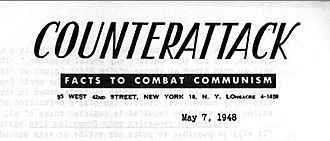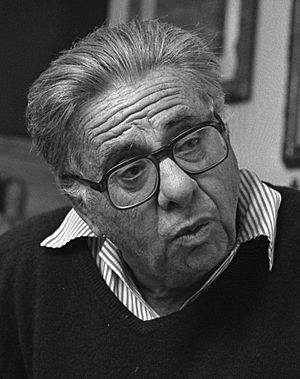Martin Ritt facts for kids
Quick facts for kids
Martin Ritt
|
|
|---|---|

Ritt in 1965
|
|
| Born | March 2, 1914 New York City, U.S.
|
| Died | December 8, 1990 (aged 76) Santa Monica, California, U.S.
|
| Years active | 1950–1990 |
| Spouse(s) | Adele Ritt (1942–1990; his death) |
| Children | 2 |
Martin Ritt (born March 2, 1914 – died December 8, 1990) was a talented American director and actor. He worked in both movies and theater. Ritt was known for making films that explored important social issues.
Some of the famous movies he directed include The Long, Hot Summer (1958), Hud (1963), The Spy Who Came in from the Cold (1965), Sounder (1972), and Norma Rae (1979). His films often showed the struggles of everyday people.
Contents
Martin Ritt's Early Life and Career
Martin Ritt was born in Manhattan, New York City. His parents were immigrants. He went to DeWitt Clinton High School in the Bronx.
Ritt first attended Elon College in North Carolina. He also played football there. Seeing the big differences between his New York City upbringing and the poor conditions in the South during the Great Depression made him care deeply about fairness. This passion for social justice later showed up in his films.
Starting in Theater
After leaving St. John's University, Ritt started working with a theater group. He began acting in plays. His first role was Crown in Porgy and Bess. People liked his acting, and Ritt realized he wanted to work in theater forever.
Ritt then joined the Works Progress Administration (WPA). This was a program started by the government during the Great Depression. It helped people find jobs. He worked as a playwright for the Federal Theatre Project. This project supported theater with government money. Many artists working for the WPA were interested in ideas about social change. Ritt felt the same way. He later said he was never a member of the Communist Party. However, he believed in many ideas about equality and fairness.
Joining the Group Theatre
Ritt moved from the WPA to the Theater of Arts. Then he joined the Group Theatre in New York City. There, he met Elia Kazan, a famous director. Kazan chose Ritt to be an understudy for his play Golden Boy. An understudy learns a role and can perform if the main actor cannot.
Ritt continued to work with Kazan for over ten years. He often helped Kazan at The Actors Studio. This was a famous place where actors learned their craft. Ritt even became a special lifetime member of the Studio.
Martin Ritt During World War II
During World War II, Ritt served in the United States Army Air Forces. He also acted in a play and movie called Winged Victory. This production was made by the Air Forces.
While Winged Victory was playing on Broadway, Ritt directed another play. It was called Yellow Jack. He used actors from Winged Victory. They rehearsed late at night, after their regular performances. This play had a short run on Broadway. It was also performed in Los Angeles when the Winged Victory cast moved there to make the film version.
Television Work and a Difficult Time
After his theater work, Ritt became a successful television director and producer. He directed episodes for shows like Danger and Somerset Maugham TV Theatre.
The Hollywood Blacklist
In 1952, Ritt faced a difficult time known as the Red Scare. This was when people in the U.S. were worried about Communism. There were investigations into whether communists had influenced Hollywood. Ritt was mentioned in a newsletter called Counterattack. This newsletter was against communism.
Counterattack claimed that Ritt had helped some labor unions with their shows. It also mentioned a show he directed for Russian War Relief. His connections to the Group Theater and the Federal Theatre Project were also noted. Eventually, the television industry stopped him from working. This was called being "blacklisted." A grocer even accused him of donating money to Communist China. For five years, Ritt supported himself by teaching at the Actors Studio.
Directing Films in Hollywood
His First Film: Edge of the City
Because he couldn't work in television, Ritt went back to theater for a few years. By 1956, the Red Scare had calmed down. He then started directing movies. His first film was Edge of the City (1957). This movie was very important to Ritt. It allowed him to share his experiences and beliefs.
The film was about a union worker who faced threats from a dishonest boss. It explored themes that Ritt often returned to in his movies. These included unfairness, racism, and how groups can pressure individuals. It also showed the importance of kindness and protecting others from harm.
Working with Stars: Joanne Woodward and Paul Newman
Ritt went on to direct 25 more films. He directed No Down Payment (1957) with actress Joanne Woodward. He also directed two movies based on books by William Faulkner, both starring Woodward. These were The Long, Hot Summer (1958) with Paul Newman, which was a big success, and The Sound and the Fury (1959).
He also directed The Black Orchid (1958) and 5 Branded Women (1960) in Europe. Ritt directed Paris Blues (1961), again with Woodward and Newman. He made another film called Hemingway's Adventures of a Young Man (1962).
Ritt and Newman had a huge hit with Hud (1963). Ritt's 1964 film The Outrage was an American version of the Japanese film Rashomon. It starred Laurence Harvey, Paul Newman, and William Shatner. Like the original, Ritt's film used flashbacks to show different points of view. Paul Newman loved his role in this movie. He even traveled to Mexico to study accents for the part.
Ritt directed The Spy Who Came in from the Cold (1965) with Richard Burton. He then made one more movie with Newman, Hombre (1967). He finished the 1960s with The Brotherhood (1968).
Martin Ritt's Films in the 1970s
In the 1970s, Ritt received praise for movies like The Molly Maguires (1970) and The Great White Hope (1970). Actors James Earl Jones and Jane Alexander earned Oscar nominations for their roles in The Great White Hope.
Other notable films from this decade include Sounder (1972), Pete 'n' Tillie (1972), and Conrack (1974).
In 1976, Ritt made The Front. This was one of the first movies to show the effects of the Hollywood blacklist. It starred Woody Allen. The Front made fun of how blacklisted writers used "fronts." These were people who pretended to write scripts that were actually written by others. The film was based on the experiences of Ritt's close friend, Walter Bernstein, who was blacklisted for eight years.
Ritt ended the 1970s with Casey's Shadow (1978) and Norma Rae (1979). Sally Field won an Oscar for Best Actress for her role in Norma Rae.
Martin Ritt's Last Films
Ritt directed Back Roads (1981) with Sally Field. He also made Cross Creek (1983). This movie told the story of Marjorie Kinnan Rawlings, who wrote The Yearling. Cross Creek was nominated for four Oscars.
He directed Murphy's Romance (1985), also starring Sally Field. In 1987, Ritt used many flashbacks in his film Nuts. This movie was based on a stage play.
Ritt's final film was Stanley & Iris (1990).
Martin Ritt's Personal Life
Martin Ritt and his wife Adele had two children. Their daughter was film producer Martina Wernerand. Their son was named Michael.
Ritt passed away from heart disease at the age of 76. He died in Santa Monica, California, on December 8, 1990.
Awards and Recognition
- Nominated, Palme d'Or Cannes Film Festival - The Long, Hot Summer (1958)
- Nominated, Best Director Directors Guild of America - The Long, Hot Summer (1958)
- Nominated, Golden Lion Award Venice Film Festival - The Black Orchid (1958)
- Nominated, Best Director Golden Globe - Hemingway's Adventures of a Young Man (1962)
- Nominated, Best Director Academy Award - Hud (1963)
- Nominated, Best Director Directors Guild of America - Hud (1963)
- Nominated, Best Director Golden Globe - Hud (1963)
- Nominated, Best Director New York Film Critics Circle - Hud (1963)
- Winner, OCIC Award Venice Film Festival - Hud (1963)
- Nominated, Golden Lion Award Venice Film Festival - Hud (1963)
- Winner, Best British Film BAFTA - The Spy Who Came in from the Cold (1965)
- Nominated, Best Director Directors Guild of America - Sounder (1972)
- Winner, Technical Grand Prize Cannes Film Festival - Norma Rae (1979)
- Nominated, Palme d'Or Cannes Film Festival - Norma Rae (1979)
- Nominated, Palme d'Or Cannes Film Festival - Cross Creek (1983)
A List of Martin Ritt's Films
- Edge of the City (1957)
- No Down Payment (1957)
- The Long Hot Summer (1958)
- The Black Orchid (1958)
- The Sound and the Fury (1959)
- 5 Branded Women (1960)
- Paris Blues (1961)
- Hemingway's Adventures of a Young Man (1962)
- Hud (1963)
- The Outrage (1964)
- The Spy Who Came in from the Cold (1965)
- Hombre (1967)
- The Brotherhood (1968)
- The Great White Hope (1970)
- The Molly Maguires (1970)
- Sounder (1972)
- Pete 'n' Tillie (1972)
- Awake and Sing! (1972 - TV)
- Conrack (1974)
- The Front (1976)
- Casey's Shadow (1978)
- Norma Rae (1979)
- Back Roads (1981)
- Cross Creek (1983)
- Murphy's Romance (1985)
- Nuts (1987)
- Stanley & Iris (1990)
See also
 In Spanish: Martin Ritt para niños
In Spanish: Martin Ritt para niños
- Harriet Frank Jr. and Irving Ravetch, a screenwriting couple with whom Ritt worked often.




